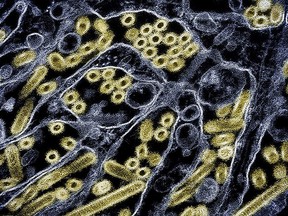This is the first human case of H5N1 in Canada in 10 years, and the first to have been contracted in Canada
Article content
A B.C. teenager who tested positive for bird flu — caused by the H5N1 strain of avian influenza — is now in critical condition and being treated in B.C. Children’s Hospital, the provincial health officer says. Here’s what to know.
What do we know about the teen?
The teen, who age and gender have not been revealed, lives in the Fraser Health region, an area to the south and east of Metro Vancouver that is home to some two million people.
Advertisement 2
Article content
Dr. Bonnie Henry, the province’s health officer, said the teen first developed symptoms, included conjunctivitis, fever and coughing, on Nov. 2. They were tested on Nov. 8 when they were admitted to hospital. As of Tuesday, Nov. 12, they were still hospitalized with acute respiratory distress syndrome, Henry said.
How did they get sick?
Henry said it’s likely the infection — the first presumptive human case of avian flu contracted in Canada — was set off by exposure to either a sick animal or something in the environment.
“Having said that, I must caution that there is a very real possibility we may not ever determine a source,” she said, per the Vancouver Sun. “But at this point, we have a number of leads that we’re following, and we will be tracking down every one.”
She added that the sick teen was not on a farm, and there are no obvious links or contacts to commercial poultry flocks. British Columbia is currently facing a wave of avian flu infections in its commercial poultry operations. Henry said about 26 premises are affected.
Is this the first case in Canada?
No, but it’s the first in 10 years, the first in British Columbia, the first contracted in Canada, and only the second in the nation overall. The only other case recorded was in Alberta in 2014, discovered in a person who likely contracted the virus while travelling in China. That person died from the infection.
Article content
Advertisement 3
Article content
Henry said there have been 46 confirmed cases of H5N1 infections in the United States this year, but the vast majority of them were cattle workers in California, Oregon and Washington who were likely infected by the virus being transmitted from birds to dairy cows and then to humans.
Infections take place when the virus is inhaled, and Henry said cases show human-to-human transmissions have been rare. Also, infections appear to pose the highest danger to younger people.
She said Tuesday that contact tracing being conducted has not identified anyone else linked to the case of the teen who has fallen ill.
What happens now?
“We don’t see right now that there’s a risk of a lot of people being sick,” Henry said, referring specifically to B.C. “One of the important things that we need to do right now — recognizing that this virus is circulating in wildfowl, so geese and ducks primarily — is to be sure that if you’re in contact with sick birds or dead birds, that you don’t touch them directly.”
She added: “Keep pets away from them … There was recently a dog, for example, in Ontario that became infected by eating a dead bird or biting a dead bird. And if the dog becomes infected, they can pass it on to humans as well.”
Advertisement 4
Article content
If you observe sick or dead birds or other wildlife and suspect that avian influenza may be involved, contact your regional avian influenza hotline or the Canadian Wildlife Health Cooperative.
Where did the disease come from?
H5N1 was first detected in birds in 1996, in southern China and Hong Kong. Since then, it has become endemic in bird populations, wiping out millions of wild and farmed birds. H5N1 has infected at least 889 people since 2003, killing a high proportion (52 per cent) of those it infects.
And while human-to-human transmission is rare, the high ratio of deaths to cases suggests bird flu “could cause a major public health emergency if human exposure and viral evolution lead to sustained person-to-person transmission,” according to an editorial in the British Medical Journal.
How likely is that?
“A full set of adaptions” would be needed for human-to-human, airborne transmission, the British researchers wrote in the British Medical Journal. But as the virus spills from birds to more and more mammal species, including, sporadically in Canada, racoons, striped skunks, red foxes, cats and dogs, “people are exposed more than ever, providing a human land of opportunity for viral mutation and recombination.”
Advertisement 5
Article content
“There are two ways the virus can learn to transmit in humans,” said Matthew Miller, scientific director of the Michael G. DeGroote Institute for Infectious Disease Research at McMaster University in Hamilton.
“It adapts by itself, which I would call the slow, and probably less risky road.” The “high-risk super highway” would be for the virus to recombine with a human virus, “or some other mammalian virus that’s better suited to human transmission.”
Recommended from Editorial
Our website is the place for the latest breaking news, exclusive scoops, longreads and provocative commentary. Please bookmark nationalpost.com and sign up for our newsletters here.
Article content








